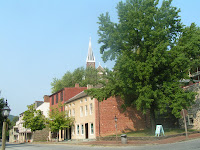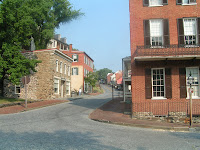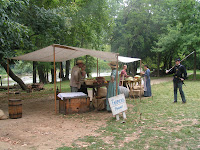We are a little bit late in updating the blog here, but it sure seems like the days fly by. Our drive from Gettysburg to Harpers Ferry was quite uneventful and took less than two hours. We knew things were going too well and ended up taking nearly two hours to level the RV! The KOA in Harpers Ferry is nice, but the pull through sites for RV parking are not very level. The campground was full the week we arrived, and they had a number of activities going on including an all you can eat pancake breakfast for $2 on both Sat. and Sun.! There was also a small museum right in the campground, and each weekend night at 6pm the Civil War cannon they have on display fires two volleys.
 Initially our trip to Harpers Ferry was planned to continue our Civil War history lesson, but neither of us realized the full scope and importance this tiny town has played in American history. Harpers Ferry witnessed the first successful application of interchangeable manufacturing, the arrival of the first successful American railroad, John Brown's attack on slavery, the largest surrender of Federal troops during the Civil War, and the education of former slaves in one of the earliest integrated schools in the United States.
Initially our trip to Harpers Ferry was planned to continue our Civil War history lesson, but neither of us realized the full scope and importance this tiny town has played in American history. Harpers Ferry witnessed the first successful application of interchangeable manufacturing, the arrival of the first successful American railroad, John Brown's attack on slavery, the largest surrender of Federal troops during the Civil War, and the education of former slaves in one of the earliest integrated schools in the United States.

Abolitionist John Brown had believed he could free the slaves and selected Harpers Ferry as his starting point because of the huge arsenal of weapons stored there. In Oct. 1859, his small army seized the armory, but within 36 hours most of his men were killed or wounded. He was captured, tried for treason, and hung. Though John Brown's short-lived raid failed, his trial and execution focused the nation's attention on the moral issue of slavery and headed the country toward civil war.
In 1861 Harpers Ferry was a bustling, thriving town, but because of the town's strategic location on the railway system, the Union and Confederate troops were constantly maneuvering and fighting over control of it. In fact Harpers Ferry changed hands 8 times during the Civil War. During the Confederacy's first invasion in Sept. 1862, Stonewall Jackson captured the town's 12,500 Union troops, the largest such surrender until WWII. After the North regained control, they instituted marshal law, and we witnessed a brief re-enactment of life for the townsfolk of Harpers Ferry during that time. 
 Several people had told us of the beauty of Harpers Ferry, located where the Potomoac and Shenandoah Rivers converge, and they did not exaggerate. This tiny historic town is surrounded by the rolling hills of the Blue Ridge Mountains. Though we did not hike up to Jefferson Rock, we did view the convergence of these two rivers from an overlook area and also drove up the hill to Church Road. The town itself has been restored to the era, with many of the stores being run by folks in period clothing as well as Union troops standing guard.
Several people had told us of the beauty of Harpers Ferry, located where the Potomoac and Shenandoah Rivers converge, and they did not exaggerate. This tiny historic town is surrounded by the rolling hills of the Blue Ridge Mountains. Though we did not hike up to Jefferson Rock, we did view the convergence of these two rivers from an overlook area and also drove up the hill to Church Road. The town itself has been restored to the era, with many of the stores being run by folks in period clothing as well as Union troops standing guard.
Abolitionist John Brown had believed he could free the slaves and selected Harpers Ferry as his starting point because of the huge arsenal of weapons stored there. In Oct. 1859, his small army seized the armory, but within 36 hours most of his men were killed or wounded. He was captured, tried for treason, and hung. Though John Brown's short-lived raid failed, his trial and execution focused the nation's attention on the moral issue of slavery and headed the country toward civil war.
In 1861 Harpers Ferry was a bustling, thriving town, but because of the town's strategic location on the railway system, the Union and Confederate troops were constantly maneuvering and fighting over control of it. In fact Harpers Ferry changed hands 8 times during the Civil War. During the Confederacy's first invasion in Sept. 1862, Stonewall Jackson captured the town's 12,500 Union troops, the largest such surrender until WWII. After the North regained control, they instituted marshal law, and we witnessed a brief re-enactment of life for the townsfolk of Harpers Ferry during that time.
Till next time!

No comments:
Post a Comment